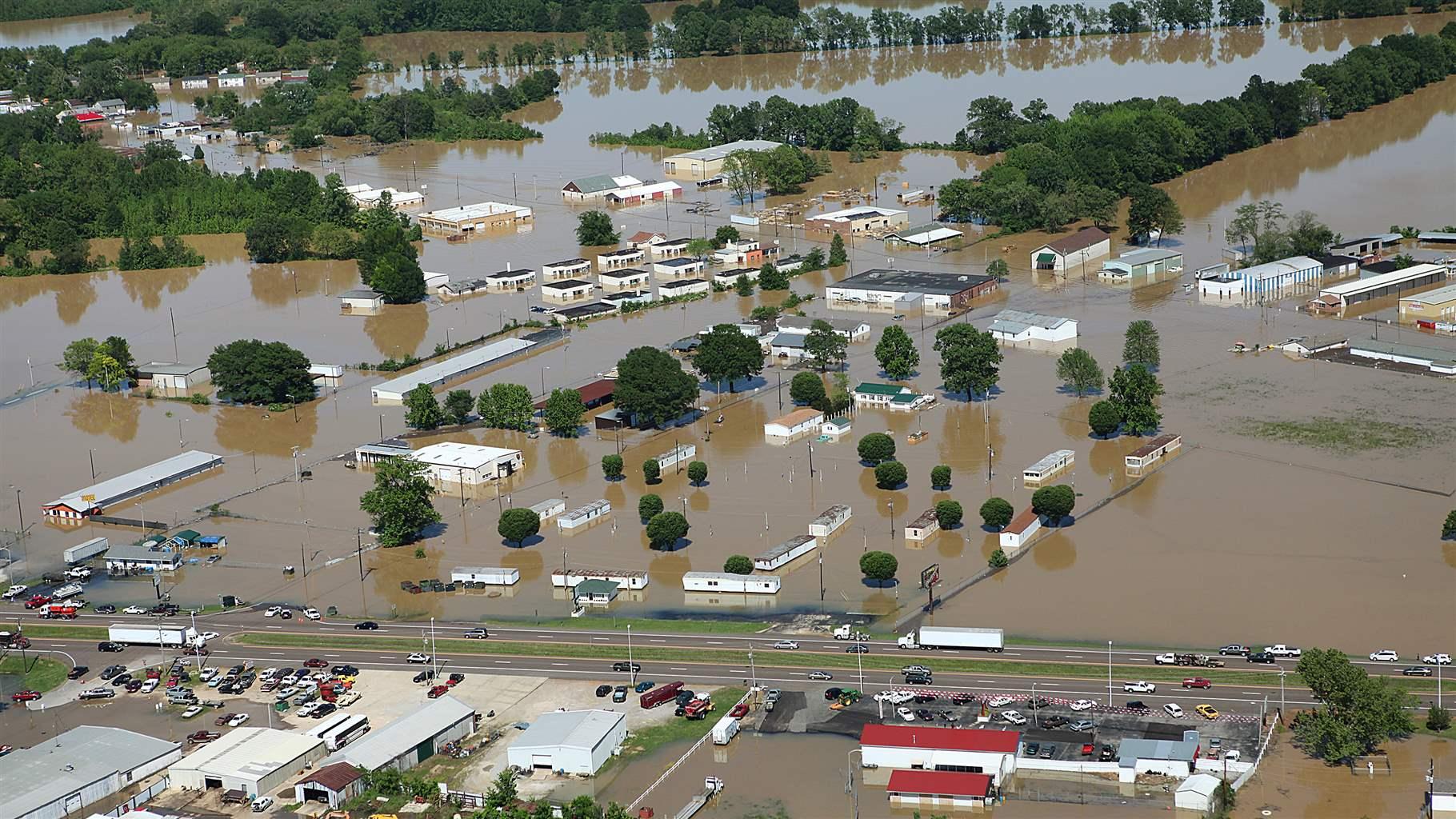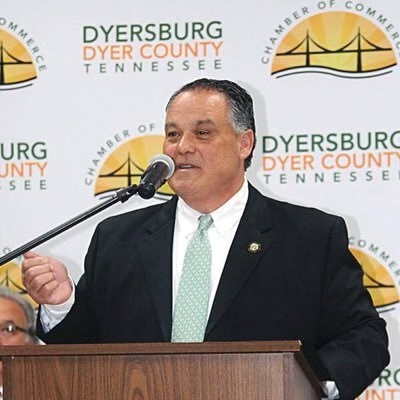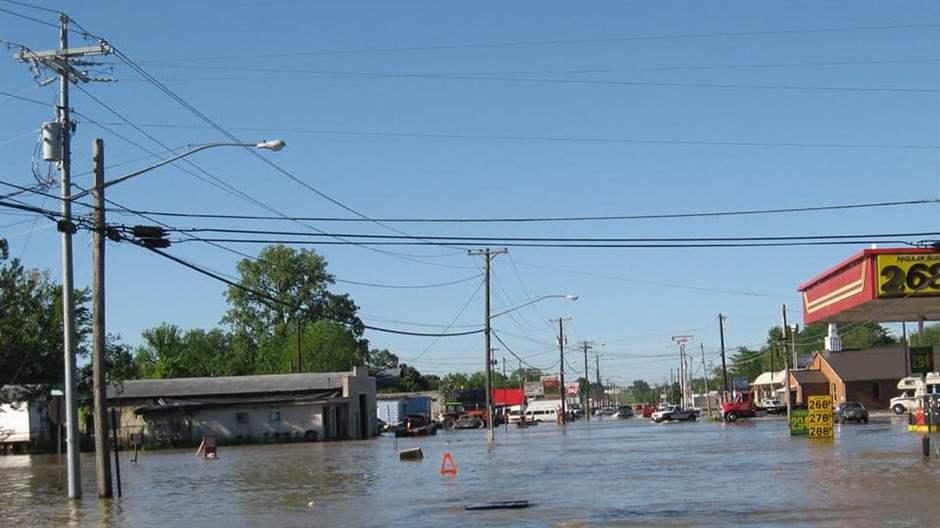Innovative Approaches and Green Infrastructure Projects Make This Tennessee Community More Resilient
Mayor of Dyersburg describes how his city has taken a big-picture approach to mitigation after catastrophic flooding

The 2011 Mississippi River flood caused almost $3 billion in damage to businesses and homes across at least seven states. In the town of Dyersburg, Tennessee, the community’s 16,500 residents were still reeling from destruction caused by flooding the year before when the disaster struck, and Mayor John Holden knew it was time to plan for a more resilient Dyersburg by embracing green infrastructure and other mitigation strategies.
Since then, he has become a key voice raising awareness at the local and national levels about efforts to improve communities’ access to proven mitigation solutions.
Mayor Holden spoke with Pew about Dyersburg’s experience and how the use of natural mitigation measures and support from the state can strengthen the resiliency of other towns.
This interview has been edited for clarity and length.
Q: How has flooding affected Dyersburg since you became mayor?
A: In the last 20 years, we have had three of the four worst floods in our history. We have a lot more intense rainfall in this region than we used to. Making things worse, water drains from several counties through Dyersburg on its way to the Mississippi River. The flooding has ruined homes and displaced residents. Several businesses along the main road coming into Dyersburg closed after the flooding. We have flood-prone areas throughout the city, which creates challenges for people looking to develop. We’re running out of land to build on that isn’t in the 100-year flood plain.
Q: Can you talk a bit about the infrastructure resilience pilot project that Dyersburg is working on with the Tennessee Department of Environment and Conservation (TDEC)?
A: TDEC approached us about assessing the conditions of our sewers and the streambanks that are within 100 feet of our sewers. Streambanks that may be eroding would threaten the integrity of our sewers. We have highly erodible soil and a lot of agricultural land, both of which lend themselves to streambank loss. We mapped and modeled streams, identifying those deemed to be in marginal or poor quality. That was overlaid with maps of sewer lines that are in poor or extremely poor condition. And we’re submitting that back to TDEC to highlight areas where we can do a deeper assessment to see if a stream might be a candidate for a pilot green infrastructure bank stabilization project.
Q: What are the most important steps your community needs to take to build flood resilience, and what stands in your way?
A: The main thing is money. There are remarkably good flood resilience solutions that can help us get away from what has been done before, like the riprap and concrete. We’ve done several environmental projects, like planting trees and wetlands. And the more we learn about how much water an adult tree actually absorbs and how we’ve got to get more water soaking into the ground instead of running over it, the more we understand how important those projects are. But they’re expensive, and budgets are tight in small communities, so that’s a limitation.
Another challenge, which a lot of rural agriculture areas have, is that the land along our waterways is farmland. There aren’t a lot of trees or other vegetation with deep roots, so the soil is unstable, and that’s a big problem in west Tennessee. It seems like there could be a collaboration with farmers to create buffers between the fields and top of the streambanks where we could have trees or native vegetation for stabilization.
It’s all about education, funding, and incentives. If there was a buffer zone program that would give an equivalent of what they would produce in acreage on soybeans, it would be a minimal amount. But there’s never been anything that would provide funding for buffers, and it will always be an issue until we get to that point.
Q: How does flooding in neighboring communities affect Dyersburg, and would state or regional coordination help to address challenges across town lines?
A: That’s an easy yes because our city limits are Dyersburg, but our drainage basins go into neighboring counties. The water doesn’t care if you’re inside or outside the city limits. It just cares where downhill is. That’s why it’s important to have some type of regional approach and for there to be dialogue between the areas so it’s collaborative. For instance, there’s a big flood resilience project in Madison County, about 42 miles from Dyersburg. And we were very excited when that got funded because they’re going to reclaim some wetlands and put storage back into the drainage basin, which is upstream of us and can manage some of the runoff coming out the city of Jackson. That helps us because then we’re not getting the stormwater rushing down the river and getting to us as quickly.
Q: How can state leadership help communities like yours prepare for flooding?
A: It’s going to take lawmakers getting educated and creating more incentives and programs to maintain flood resilience. We can’t stop the rain from coming; we can’t build levees everywhere. The only solution is to maximize how much water gets absorbed through plantings and other green infrastructure and to reduce the sediment going into our tributaries, so the water can leave.
The state can really help communities that don’t have the know-how or staff to plan better. Dyersburg has a part-time city engineer, which puts us in a better position than any other city in west Tennessee, besides Jackson; nobody else has a city engineer. Engineers are not cheap, and a lot of small towns can’t afford one. Local engineers also maybe haven’t done a lot of work outside their town and may not know about new regulations, new technologies, or grant opportunities. The state can give towns resources to help answer questions about flood maps or levees or repeated flooding. All cities would be better off with more information and advice from the state.
Q: What would a more resilient Dyersburg mean for the people who live and work here?
A: It would be a boost to the economy, and that benefits everybody. We would have more marketable land. We can’t make the flood not happen, but we want to lower its impact. The areas most impacted by flooding are the poorest parts of Dyersburg; they are the people that can’t afford to leave or recover. A town lives and dies by how its lowest-income residents live, so if we could improve the resiliency of Dyersburg, then there’s the possibility to bring up the poorest parts of our town. From a flood perspective, resilience is really important for our future. There was a time when I thought there was no hope, but with the problem being so widespread now throughout the country, people are turning their attention to it, and, in our town and across our state, we know we’re going to have to do a better job.














